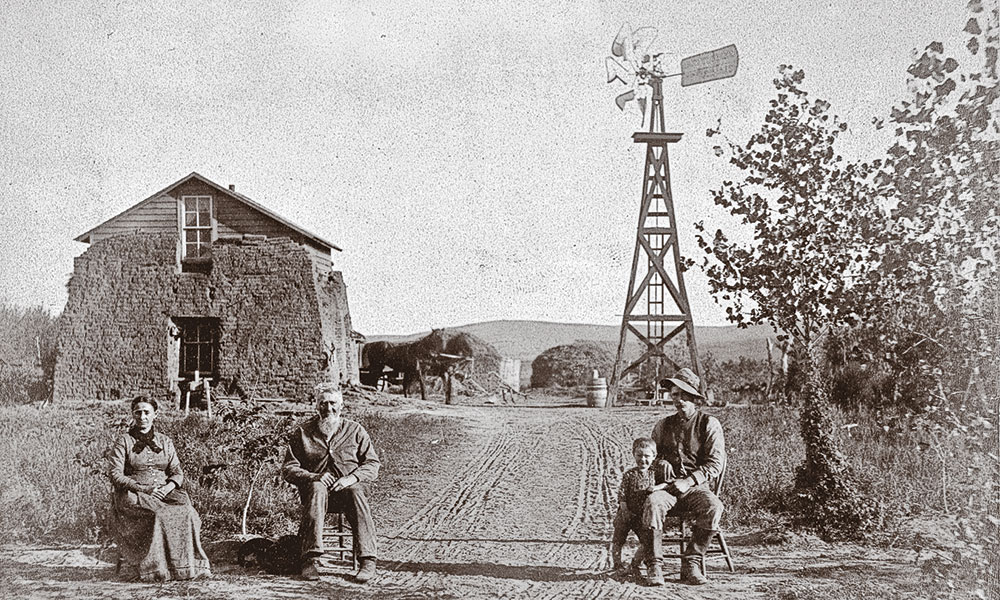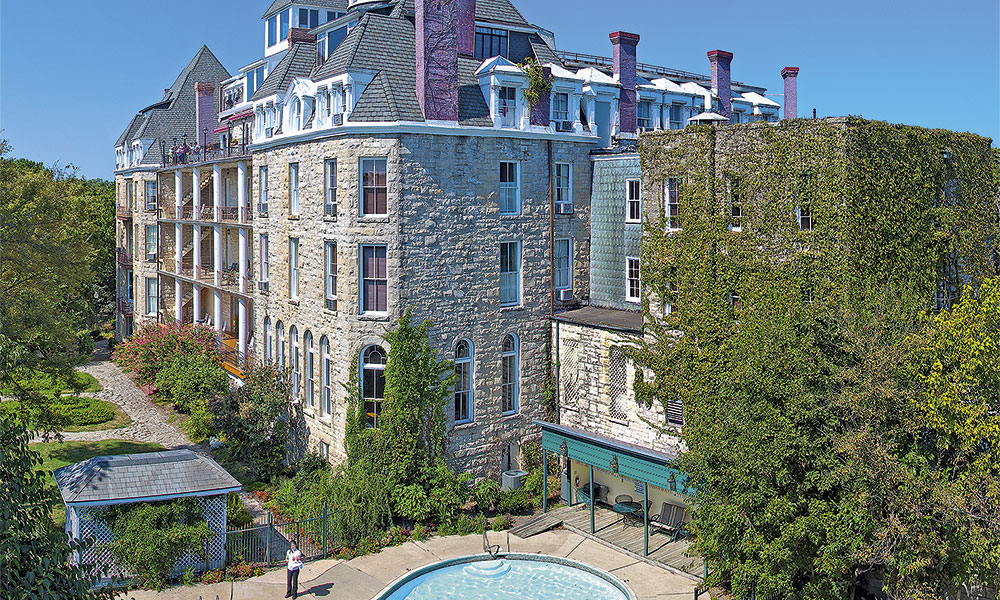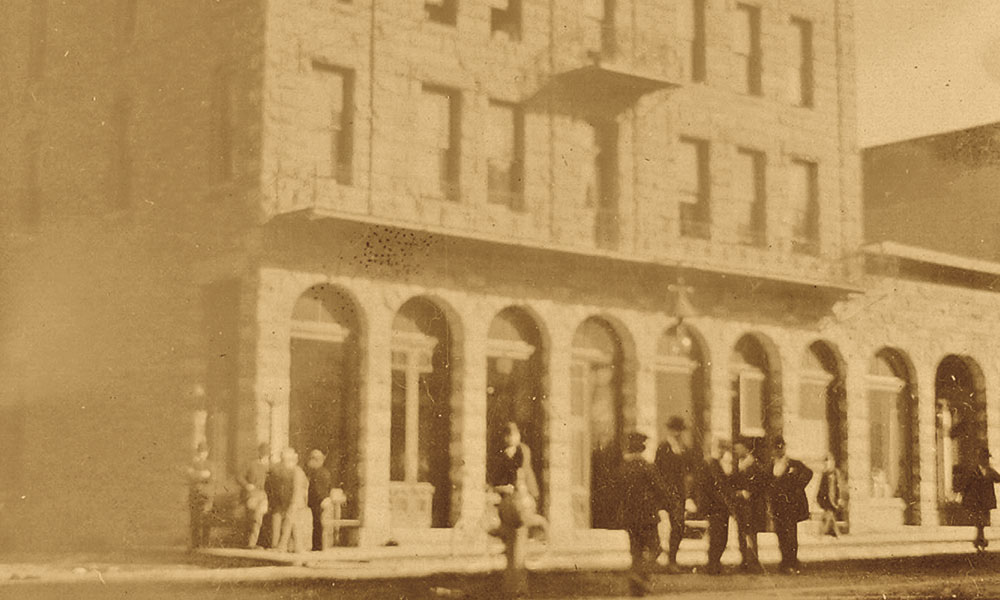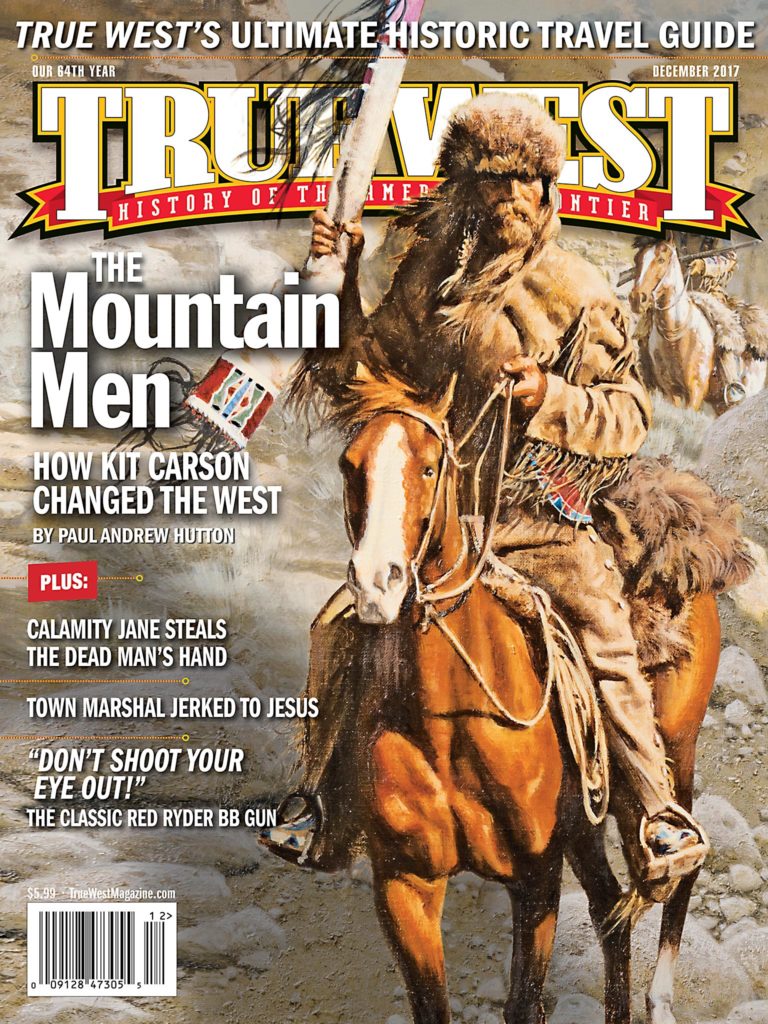
— Photo by Solomon Butcher, Courtesy of Library of Congress —
The Southern Prairie and Plains states should be considered the gateway states to the West.
From the lesser-known trails to Texas and Oklahoma from Louisiana and Arkansas to the great epicenters of national trail history in St. Louis, Independence and St. Joseph, Missouri, the trails offer heritage travelers historic routes for transcontinental trips from Missouri on National Historic Trails as far away as Santa Fe, New Mexico, Sacramento, California, and Astoria, Oregon.
In Kansas and Nebraska respectively, the vistas of the Great Plains inspire visitors to follow the famous Santa Fe and Oregon Trails westward, while inviting tourists to stop and explore the historic sites associated with the great cattle drives and military Indian War campaigns.
Travel in the Southern Prairie and Plains region ties together the national story of the Trans-Appalachian West with the Trans-Mississippi West and how the competing empires of Spain, France, Great Britain and the United States vied to wrestle control of North America from the indigenous American Indian tribes.
Arkansas
Fort Smith Belle Grove Historic District
Belle Grove, one of the most significant historic districts in Arkansas, is a 22-block area of homes dating back 130 years adjacent to Fort Smith National Historic Site and the Arkansas River.
Four homes are open for public tour: The Clayton House, McKibben-Bonneville House, Fort Smith Art Center and the Darby House.
Fort Smith CVB: 2 North B St, Fort Smith, AR 72901
479-783-8888 • FortSmithAR.gov
Fort Smith National Historic Site
In the annals of American Trans-Mississippi history, Fort Smith, founded in 1817, was an important gateway city to the West.
While Missouri’s St. Louis, Independence and St. Joseph receive more attention in the history books, Fort Smith’s role in the development and settlement of Western territories, including Oklahoma, Texas and Kansas, must be considered.
The National Park Service’s Fort Smith National Historic Site is one of the largest, best-preserved interpretive centers of a historic 19th-century federal post west of the Mississippi.
Tours should begin at the Visitor Center in the fort’s former barracks/courthouse/ prison.
Fort Smith may have been best known as the court of Judge Isaac Parker, the hanging judge.
Visitors can tour the 37-acre grounds of Fort Smith on a 1.4-mile self-guided tour of all the key historic structures and sites, including the Gallows, Commissary and Trail of Tears National Historic Trail Overlook.
Fort Smith CVB: 2 North B St, Fort Smith, AR 72901
479-783-8888 • NPS.gov
Historic Washington State Park
Founded on George Washington’s birthday in 1824, Washington, Arkansas, is a National Register of Historic Places site, and one of the best preserved Southern villages west of the Mississippi River.
Historic Washington State Park includes 30 preserved and restored architecturally important buildings constructed between 1824 and 1900.
Numerous exhibits and collections can be enjoyed in the buildings open to the public, with re-enactors acting as hosts and guides.
Start at the Visitor Center and inquire about programs, activities and tours of the historic town.
103 Franklin St, Washington, AR 71862
870-983-2625 • HistoricWashingtonStatePark.com
Pea Ridge National Military Park
Known as the “battle that saved Missouri for the Union,” Pea Ridge National Military Park preserves and interprets across 4,300 acres one of the most significant, and lesser-known major engagements of the Civil War in northwestern Arkansas.
On a late winter day, March 27, 1862, 26,000 Union and Confederate soldiers clashed in one of the wars’ largest Western battles. When the smoke cleared, the Federal forces had thwarted the Southern army from taking control of northern Arkansas and advancing into Missouri.
Begin a tour at the Visitor Center’s museum, where visitors can sign up for guided tours in the summer.
One of the best ways to see the battle is to drive the park’s interpretive loop, but the park also has walking and horse trails. Contact the park for a schedule of re-enactments and events.
15930 E Hwy 62, Garfield, AR 72732
479-451-8122 • NPS.gov
Prairie Grove Battlefield State Park
The Battle of Prairie Grove was significant in the history of the Western Theater of the Civil War.
One of the most intact battlefields of the War Between the States, Prairie Grove Battlefield State Park preserves the site that left 2,700 dead or wounded in northwest Arkansas on December 7, 1862.
Visitors may need more than one day to walk the battlefield trail, take the driving tour, visit historic Ozark Village and tour the park’s museum and visitor center in Hindman Hall.
A biennial event, the Battle of Prairie Grove Re-enactment will be held 5-17, 2018. Inquire with the park for more information.
506 E Douglas St, Prairie Grove, AR 72753
479-846-2990 • ArkansasStateParks.com
Kansas
Condon Bank Building
Rivaling the James-Younger Gang’s failed bank robbery in Northfield, Minnesota, is the Dalton Gang’s disastrous attempt to rob two banks, C.M. Condon and First National, simultaneously in Coffeyville, Kansas, on October 5, 1892.
Convenient for visitors to Coffeyville, the area’s Chamber of Commerce is located in the original site of the C.M. Condon Bank, the 1871 Perkins Building, in the city’s historic district.
The chamber is open Monday to Friday and the bank vault, tellers’ area and lobby can be seen as they were on that fateful day.
From the Perkins Building, take a walking tour of the district to the Dalton Defenders Museum.
The graves of Bob and Grat Dalton and Bill Powers can be visited in Coffeyville’s Elmwood Cemetery.
807 Walnut, Coffeyville, KS 67337 • 620-251-5500 CoffeyvilleChamber.org / DaltonDefendersMuseum.com
Constitution Hall
The history of Kansas is inexorably tied to both the development of America’s expansion westward to the Southwest, Great Plains and the Northwest, and to the national political debate on the abolition of slavery and the Civil War.
Historic Lecompton should be on everyone’s tour of key heritage sites related to the Kansas-Missouri Border War.
Constitution Hall was built in 1856 and is where the Kansas Territorial government first convened and wrote a pro-slavery constitution.
After two years of conflict with Kansas anti-slavery factions, the seat of power was wrested from Lecompton’s leaders and moved to Lawrence.
Visit Constitution Hall, the Territorial Capital Museum or its website for information on a self-guided tour of the historic city.
319 Elmore St, Lecompton, KS 66050
785-887-6520 • LecomptonKansas.com
Dodge City
“The Queen of the Cow Towns,” Dodge City’s iconic status stands equally with that of Deadwood, Lincoln and Tombstone.
A tour of Dodge City should begin at the Visitor Information Center for an orientation and guide to the city.
Take the Historic Trolley Tour (Memorial Weekend to Labor Day), pick up a map of the Dodge City Trail of Fame and visit the internationally acclaimed Boot Hill Museum.
Boot Hill is known for its outstanding exhibits on frontier Kansas history, firearms, gambling, buffalo hunters and the Wild West era of cattle drives.
Visitors will enjoy walking amongst the historical interpreters and watching gunfight re-enactments on Front Street and the Variety Show in the Long Branch Saloon.
While in Dodge City, don’t miss a visit to the Gunfighters Wax Museum, and the Wild West Heritage Foundation’s Buffalo and Longhorn Exhibit.
620-225-8186 • VisitDodgeCity.org
Fort Hays State Historic Site
First constructed in 1866, Fort Hays served the strategic needs of the U.S. Army in Western Kansas at three different sites until it was decommissioned in 1889.
Commanders included Nelson Miles and Phil Sheridan, and was garrisoned by the 5th Infantry, 7th Cavalry and 10th Cavalry regiments, the latter a unit of Buffalo Soldiers.
From 1867 until 1869, Maj. Gen. Sheridan and Lt. Col. George A. Custer were headquartered at Fort Hays in their war with the Southern Cheyenne and Kiowa people.
Visitors will enjoy regularly scheduled re-enactment events, rangers in period dress, a museum and walking tours of the parade ground and four historic buildings.
1472 U.S. Hwy 183 Alt, Hays, KS 67601
785-272-8681 • KSHS.org
Fort Larned National Historic Site
The Army troops posted at Fort Larned were known as “the guardians of the Santa Fe Trail.”
Built in 1859, the outpost’s buildings were constructed of native quarried sandstone, the reason Fort Larned National Historic Site remains one of the best-preserved Western outposts in the United States.
Fort Larned is a living history center, with rangers and docents in period dress providing daily and monthly educational programs about life at a frontier Army post.
Guided tours held May-September of the best way to learn the history of Fort Larned.
1767 Kansas 156, Larned, KS 67550
620-285-6911 • NPS.gov
Old Abilene Town
Abilene was founded in 1857, but it was the arrival of the Kansas Pacific Railway in 1867 that transformed Abilene into the legendary town at the end of the Chisholm Trail from Texas.
Old Abilene Town is dedicated to promoting and preserving the colorful and popular heritage of the “wickedest and wildest” cow town of all the Kansas cow towns.
Visitors to Old Abilene Town will enjoy re-enactors in period costume, gunfight re-enactments, special events and stagecoach and steam engine rides.
Three other notable museums not to miss when visiting Abilene, Kansas: Dickinson County Heritage Center, the Dwight D. Eisenhower Presidential Library, Museum and Boyhood Home and the Historic Seelye Mansion.
100 SE 5th St, Abilene, KS 67410 • 785-479-0952
OldAbileneCowtown.com / AbileneCityHall.com
Medicine Lodge Treaty Site
The Medicine Lodge Treaty Site National Historic Landmark in Kansas is as important as Fort Laramie National Historic Site in Wyoming in understanding how the United States government negotiated with the Plains Indian tribes for land ownership and rights in the 19th-century settlement and conquest of the Indian Nations West.
The historic importance of the three treaties is honored every two years by the Medicine Lodge Treaty Association at the Medicine Lodge Treaty Indian Summer Days.
Medicine Lodge Indian Peace Treaty Association
P. O. Box 194, 103 E Washington
Medicine Lodge, KS 67104 • 620-886-9815 • PeaceTreaty.org
Louisiana
Chalmette Battlefield Site
On January 9, 1815, General Andrew Jackson led U.S. forces over the British in a resounding victory to end the War of 1812 at Chalmette Battlefield Site (Battle of Orleans), now Jean Lafitte National Historical Park and Preserve.
Visitors to the national park can walk the field of battle and learn how Jackson’s victory changed the course of history for the United States and the world.
Tour the informative museum at the Battlefield’s Visitor Center before enjoying the self-guided tour and visit to the Chalmette Monument, a 100-foot obelisk with 122 interior steps to the top.
A unique way to visit the park is by the Creole Queen paddlewheeler from New Orleans’ French Quarter; inquire with the park for information.
8606 W St Bernard Hwy, Chalmette, LA 70043
504-281-0510 • NPS.gov
Confederate Memorial Hall Museum
The influence of the Southern United States and the Confederacy on the settlement, politics and war in the American West is a critical part of the story of 19th-century America.
Opened in 1891 in New Orleans’s Warehouse District, the Confederate Memorial Hall Museum is dedicated to honoring Southern history.
929 Camp St, New Orleans, LA 70130
504-523-4522 • ConfederateMuseum.com
The 1850 House
In New Orleans’s Jackson Square, the 1850 House museum is dedicated to the family history of Baroness Micaela Almonester de Pontalba, whose father, Don Andres Almonester y Roxas, funded the construction of St. Louis Cathedral.
The Upper and Lower Pontalba Buildings are considered the oldest apartment houses in the nation. The museum has re-created one of the residences to mirror middle class life in antebellum New Orleans.
523 St. Ann St, New Orleans, 70116
504-524-9118 • The1850House.com
Fort St. Jean Baptiste Historic Site
The French were in Natchitoches in west-central Louisiana trading with local Indians as early as 1699.
The trading post on the Red River was founded in 1714 and Natchitoches was the oldest city in the Louisiana Purchase.
The Fort St. Jean Baptiste Historic Site reconstructs the French fort built in defense of the Spanish Empire.
When in the area, don’t miss a tour of historic Natchitoches, and the nearby Fort Jesup State Historic Site, built under the leadership Lt. Col. Zachary Taylor as a key American outpost between the Red and Sabine rivers in 1822.
155 Rue Jefferson, Natchitoches, LA 71457
318-357-3101 • Natchitoches.net / Crt.State.LA.us
Spring Street Historical Museum
The Shreve Town Company founded Shreveport to develop a town at the crossroads of the Texas Trail and the Red River in 1836.
The development led to the opening of the river as a navigable waterway for steamships with the clearing of the Red River’s infamous Great Raft logjam.
The Spring Street Historical Museum exhibits provide an informative and educational window into the history of the Louisiana city which served as a gateway to the West.
525 Spring St, Shreveport, LA 71101
318-424-0964 • SpringStreetMuseum.com
Missouri
Gateway Arch and Old Courthouse Building
St. Louis’s Gateway Arch, an internationally recognized landmark of the “Gateway City,” is the centerpiece of the city’s historic district.
Currently, the Museum of Westward Expansion, located under the Gateway Arch is closed for major renovations, and visitors wanting to visit the Arch should go to the Old Courthouse Ticket Center.
The Old Courthouse is one of the most significant historical sites in Missouri, with several galleries dedicated to St. Louis’s history, and the river city’s role in Westward Expansion and Southern history.
11 N 4th St, St Louis, MO 63102
314-655-1700 • GatewayArch.com / NPS.gov
Independence Historic District
The original trailhead of the Santa Fe Trail, historic Independence on the Missouri River remains one of the most important and influential frontier cities that shaped America’s expansion West.
Start your visit to Independence at the Visitor Experience Center and then take a self-guided walking tour of Independence Square.
While in Independence be sure to see where Frank James was incarcerated at the 1859 Jail & Marshal’s Home; visit the National Frontier Trails Museum; and schedule a covered wagon tour with Pioneer Trails Adventures.
112 W Lexington, Independence, MO 64050
816-325-7890 • CI.Indpendence.MO.us
James Farm
Until 1978, the James Farm was owned by descendants of the famed outlaw Jesse James.
Today, the historic site in Kearney, Missouri, is a Clay County Museum dedicated to the James Family, the history of the region, the Border War and the Jesse and Frank James years as outlaws.
The Visitors Center and Museum is in the restored 19th-century family home.
21216 Jesse James Farm Rd, Kearney, MO 64060
816-736-8500 • JesseJames.org
Jesse James Home/Patee House Museum
Located on the grounds of the Patee House Museum stands the Jesse James Home, where the famous outlaw was shot and killed by Robert Ford on April 3, 1882.
The Patee House was built as a hotel in 1858, was the headquarters for the Pony Express in 1860-’61 and was occupied by the Union Army during the Civil War.
A National Historic Landmark, the Patee House has a superior collection of exhibitions dedicated to 19th-century Missouri life. The Jesse James House has an exhibit on Jesse James’s life in St. Joseph and his grave.
1202 Penn St, St. Joseph, MO 64503
816-232-8206 • PonyExpressJesseJames.com
Mark Twain Historic District
Walk the streets of historic Hannibal and a visitor can imagine a young Samuel Clemens growing up in the town and playing by the the Mississippi River.
Start at the Mark Twain Boyhood Home and Museum, which includes eight historic properties, for a complete immersion into the real life of Twain.
Tour the Mark Twain Interpretive Center and discover how the great American author transformed his own life and friends into the imaginary lives of his novel’s fictional characters.
Two tours not to miss: Mark Twain Cave and the Mark Twain Riverboat cruise on the Mississippi.
120 N Main St, Hannibal, MO 63401
573-221-9010 • ExploreHannibal.com / MarkTwainMuseum.org
St. Joseph Historic District
Known best as the trailhead for the Pony Express, St. Joseph’s historic district will inspire the imagination and remind visitors of the importance of Missouri’s western frontier towns to American history.
Begin tours of historic St. Joseph at the Pony Express Museum, followed by a visit to the extraordinary St. Joseph Museum, with its extensive displays on the culture and history of the region, including American Indian and Civil War exhibitions.
Also, don’t miss the Patee House Museum, Jesse James Home, Robidoux Row Museum and Pony Express Monument.
St. Joseph CVB, 109 South 4th St, St. Joseph, MO 64501
800-785-0360 • StJoMo.com
Westport Landing
While St. Louis, Independence and St. Joseph receive more attention from historians—and have more historic sites associated with the Western trails—Westport Landing was actually the site that wagon trains and wagon train bosses preferred for many years to prepare and provision for the transcontinental journey to Oregon or Santa Fe.
Visit the Harris-Kearney House Museum managed by the Westport Historical Society in the Kansas City suburb of Westport and learn about life in the 19th-century frontier town and its role in the development of the West.
4050 Pennsylvania Ave, Suite M100, Kansas City, MO 64111 • 816-531-4370
WestportHistorical.com
Nebraska
Buffalo Bill State Historical Park
Buffalo Bill State Historical Park preserves Scout’s Rest Ranch, the home of the great Western showman William F. “Buffalo Bill.”
Cody first began ranching in the area in 1877 and began building a major farm and ranch operation in North Platte in 1878.
A major enterprise, the Nebraska ranch was home to Cody and his family for many years. He owned the property until 1911.
The park includes the Cody House and barn. The ranch is also noted as the place Cody debuted his Wild West show, known as the Old Glory Blowout, in 1882.
2921 Scouts Rest Ranch Rd, North Platte, NE 69101
308-535-8035 • VisitNorthPlatte.com OutdoorNebraska.gov
Chimney Rock National Historic Site
A landmark for travelers in the North Platte River Valley for chimney rock in the Sand Hills of western Nebraska, is today protected as Chimney Rock National Historic Site.
The unique geological site is just east of Scotts Bluff, another significant landmark in the area. Explorers, fur trappers and emigrants used the landmarks to guide them as they traveled the Oregon Trail.
Chimney Rock is managed by the Nebraska Historical Society and includes a Visitor Center Museum.
Chimney Rock Trail, Bayard, NE 69334
308-586-2581 • NebraskaHistory.org
Fort Kearny State Historical Park
Fort Kearny State Historical Park preserves and promotes the history of the U.S. Army’s role in protecting the Overland Trails along the Platte River in central Nebraska.
Founded in 1848, Fort Kearny served the region until 1871. In 1928, the Fort Kearny Historical Society bought 40 acres for a park and rebuilt key structures: the stockade, powder magazine, carpenter-blacksmith shop and the parade grounds.
The park has an interpretive center and hosts living history events throughout the year.
1020 V Rd, Kearney, NE 68845
308-865-5305 • OutdoorNebraska.gov
Fort Robinson State Park
Fort Robinson State Park is one of the most historically significant—and largest—state parks in Nebraska.
Near Crawford, with dozens of historical buildings and museums on site, Fort Robinson encompasses 22,000 acres, with numerous houses and camping spots for rent.
Fort Robinson was founded in 1874 and served the Army until 1947. Fort Robinson was involved in critical events of the Great Sioux War, including as the site where Crazy Horse surrendered and was later killed, the Dull Knife breakout of the Northern Cheyenne and the Fort Robinson Massacre.
Soldier Creek Rd., Crawford, NE 69339
308-665-2900 • OutdoorNebraska.gov
Homestead National Monument of America
The Homestead National Monument of America in Beatrice, Nebraska, honors the history of homesteading and the men, women and families who staked so much on 160-acre homesteads with the hope of building an independent life and future.
Tours should begin at the Heritage Center, which has an excellent museum, followed up by an outdoor tour of the park, including the Education Center, Palmer-Epard Cabin and Freeman School.
8523 NE-4, Beatrice, NE 68310
402-223-3514 • NPS.gov
Rock Creek Station State Historical Park
Rock Creek Station State Historical Park is the site of the stagecoach station where James Butler “Wild Bill” Hickok had his shootout with Dave McCanles.
Working as a stock boy, Hickok feuded with the local McCanles ending with Wild Bill’s enemy dead, and beginning a Western legend’s career as a gunfighter.
57426 710th Rd, Fairbury, NE 68352
402-729-5777 • OutdoorNebraska.gov
Scotts Bluff National Monument
Scotts Bluff National Monument is dedicated to interpreting the culture, heritage and history of Scotts Bluff and the North Platte River Valley.
During the early 19th-century, European and American fur trappers plied the paths along the North Platte to and from the West, marking a key trail that would guide the way West for successive generations of emigrants.
Tours of the park should start indoors at the Visitor Center, but the strength of the monument is in its numerous trails, including the Oregon Trail Pathway and the North and South Overlook.
190276 Old Oregon Trail, Gering, NE 69341
308-436-9700 • NPS.gov





